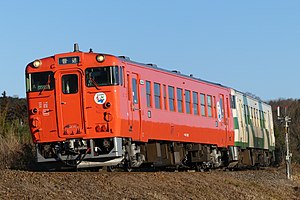This article has multiple issues. Please help improve it or discuss these issues on the talk page. (Learn how and when to remove these messages)
|
| KiHa 40 series KiHa 41 KiHa 47 KiHa 48 | |
|---|---|
 A pair of JR East KiHa 40 series units on the Karasuyama Line in January 2017 | |
| In service | 1977–present |
| Manufacturer | Fuji Heavy Industries, Niigata Tekkō |
| Replaced | |
| Constructed | 1977–1983 |
| Number built | 888 vehicles |
| Number in service | 714 vehicles (as of 2018)[1] |
| Successor | |
| Formation | Various |
| Operators |
|
| Depots | Various |
| Lines served | Various |
| Specifications | |
| Car body construction | Steel |
| Car length | 21,300 mm (69 ft 11 in) |
| Width | 2,900 mm (9 ft 6 in) |
| Doors | 2 per side |
| Maximum speed | 95 km/h (59 mph) |
| Transmission | DW10 (hydraulic) |
| Multiple working | KiHa 58 (San'in Main Line only) |
| Track gauge |
|
The KiHa 40 series (キハ40系, Kiha-yonjū-kei) is a diesel multiple unit (DMU) train type introduced by Japanese National Railways (JNR) in 1977 and operated by all Japan Railways Group companies on suburban and rural services in Japan.[2] Since 2017, the train type has seen use by other private railway companies in Japan, following the removal of services by Japan Railways groups. Additionally, it has also seen use in overseas operations in Myanmar since 2011 and is also scheduled to be used in Thailand.
- ^ Cite error: The named reference
railfan597was invoked but never defined (see the help page). - ^ Haraguchi, Takayuki (2009). Encyclopedia of JR's Railway Cars: JR全車輌. Japan: Sekai Bunka. pp. 126–127. ISBN 978-4-418-09905-4.
